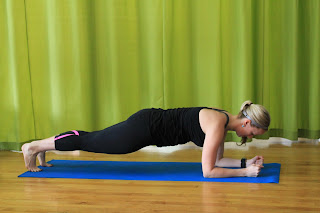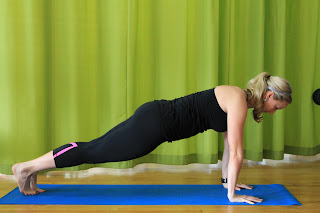By Susie Crossland-Dwyer
The Challenge:
Build up to a 5:00 min. plank hold (forearm or straight-arm).
The Method:
-Use these dynamic plank variations to help improve your core strength and pelvic stability while preventing boredom of simply holding plank.
Practice these variations 2-3 times per week.
Perform as few repetitions of each exercise as you need to in order to keep correct form.
Please note that
any of these variations can also be performed starting from your forearm plank (if you have wrist or elbow issues).
-In addition, find a 5:00 min. song you like to test your progress in your plank hold. Each time you practice your plank hold, play the song and try to get 5-10 seconds further into. Before you know it, you will have conquered a MEGA 5:00 plank!
The Basics: Straight-Arm & Forearm Plank (& modified)
I'm often asked which one of these planks is better for you or harder to do. Try both and see what you think. Forearm plank tends to focus on more core strength but straight-arm plank is especially good for women to develop more upper body strength.
Straight-Arm
Forearm Plank
Modified Plank
Positioning:
-In all variations, shoulders should be stacked on top of wrist or elbow (for forearm plank).
-If you drew a line from the top of your head to your heels, it should be almost straight. To maintain this position and protect the back, the navel should be pulled into the spine at all times.
-Pay attention to the position of the head. Tuck the chin slightly to create length on the back of the neck.
-The closer together the feet are, the harder the plank becomes.
Common Mistakes: Position of the pelvis is too high (butt in the air) or too low (back is arched), head is lifted too high
Variation #1=Toe-to-Heel Shifting Plank
Positioning/Progression:
-Start in a straight-arm plank.
-Shift the body weight forward onto the toes momentarily (shoulders will come forward of the wrists) and then shift back, pressing into the heels (shoulders will come behind the wrists).
Do both of these movements without changing the position of the pelvis.
-Shift for as many full breaths as you can--starting with the goal of 10 inhale/exhales.
Inhale as you go forward onto the toes, exhale as you press back through the heels.
Visualization: Picture a hot cup of coffee resting on your back. As you shift to the toes and back into the heels, you want to visualize keeping the cup level and not spilling it.
Common Mistake: lifting the butt up as you shift back into the heels
Variation #2=Plank Single-Leg Knee Tuck
Option #1 Flat Back Knee Tuck

Option #2 Round Back Knee Tuck
 Positioning/Progression:
Positioning/Progression:
-Start in a straight-arm plank.
-Drive one knee toward the same elbow while either a) keeping the pelvis level or b) rounding through the back and pulling the core in (navel to spine).
-Lengthen the leg back out without setting it down on the floor.
-Keep the upper body still as the knee drives in and lengthens back out.
-Repeat x10 on each side, focusing on one side at a time.
Common Mistakes: Shifting the upper body forward with the movement of the leg or arching the back too much as the leg lengthens back out
Variation #3=Plank Knee 90
 Positioning/Progression:
Positioning/Progression:
-Start in a straight-arm plank.
-Lift one leg and drive the knee toward the elbow.
-Keep the knee bent and rotate the shin perpendicular to your torso.
-Shift the leg even deeper across the body (away from starting position).
-Perform up to 10-15 shifts across the body before releasing the leg back to the floor.
Visualization: Picture you are threading a needle as you take the leg across the body
.
Common Mistake: Letting the rest of the body shift as the leg shifts
Variation #4=Plank Leg Pull

 Positioning/Progression:
Positioning/Progression:
-Start in a straight-arm plank.
-Lift one leg off of the floor without changing the position of the pelvis (by engaging through the abdominals). Keep the leg straight as you point through the foot and then flex through the foot.
-Set the foot back down and repeat on the same side.
-Repeat x10-15 each side.
Common Mistakes: Lowering through the pelvis as the leg lifts, lifting the leg too high
Variation #5=Transitional Plank


 Positioning/Progression:
Positioning/Progression:
-Start in straight-arm plank.
-Hold for 10 seconds.
-Lift your right arm first to lower you down to forearm plank (without dropping to the knees).
-Hold 10 seconds.
-Press back up to straight-arm plank lifting the right arm first.
-Repeat the same method but switch to lifting the left arm first.
-Complete as many full transitions as possible--starting with the goal of four.
Common Mistake: Rocking the pelvis side-to-side when lowering and lifting
.JPG)












